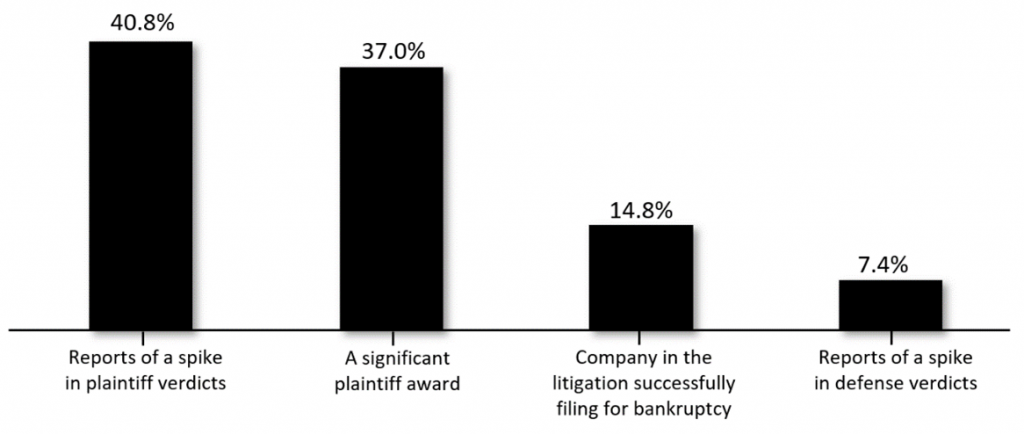New Study Reveals Asbestos Risk Value Factors Are Shifting

Billions of dollars continue to be paid annually in litigation related to asbestos personal injury claims despite original projections that asbestos litigation would be exhausted by 2023. A recent survey of experienced asbestos litigation professionals provides insight into the changes and the impact on risk factors utilized to assess the litigation value. The results provide clear evidence that new risk factors are driving the value of ongoing risk in asbestos cases, and there is an absolute need for data-driven risk analysis.
Notably, while nearly all survey respondents say early risk assessment is valuable, not all indicate they are doing it in the day-to-day work related to specific cases. On a macro level, those respondents recognized the factors in 2023 that shift overall risk. The majority view is the risk needle is moved more by headlines of plaintiff wins, large plaintiff awards, and the actual attorney representing a party more than the resources of a law firm. And, although discussions among those with historical asbestos knowledge indicate bankruptcy shifts the litigation risk, respondents reported that a defendant successfully moving into bankruptcy does very little in 2023 to impact the value of a case.
Big name national law firms have little value in asbestos litigation
A resounding 97% of respondents say that the individual attorney representing a party impacts risk more on day one than the size or reputation of the law firm. Despite the recognizable tag lines by national law firms, both plaintiff and defense, that size matters, those surveyed see things differently when looking through the risk lens.

Question 1. “Which do you think impacts risk more on day 1?”
Significant plaintiff verdicts make news and shift the risk in asbestos litigation
If law firm reputation and bankruptcy are not the driving forces in risk value in 2023, what factors are most impacting risk values? 75% of respondents say that case risk is most impacted by reports of a spike in plaintiff verdicts or significant plaintiff awards. It is unclear from the results if the verdict or actual amount awarded impacts the risk or if the money spent by plaintiffs’ firms advertising wins and awards may be driving this factor. Several respondents noted that defense wins are rarely advertised, tracked, and often not shared, resulting in one-sided marketing of plaintiff’s victories in the daily news stream.

Question 2. “Which headline do you think would most impact asbestos case risk?”
National news coverage related to talc creates red herring in asbestos litigation
When asked to rank risk factors that affect case value in asbestos cases from highest to lowest, survey respondents revealed talc exposure rates very low, with only 15% of respondents ranking it in their top 3. Despite the media attention over the past several years, the predictions and discussions among well-seasoned asbestos litigators, highly publicized cases, and research drawing attention to the emerging liability threat of talc exposure, asbestos professionals surveyed say that talc is nowhere near the risk factor of jurisdiction or plaintiff law firm.

Question 3. “How would you rank the list of risk factors in asbestos litigation?”
(highest = 1 to lowest = 5)
Asbestos companies and insurers not requiring early risk evaluation despite survey results indicating respondents consider it valuable and essential
Nearly 70% of participants say that early case evaluation is valuable and essential to asbestos cases, but less than a third say it is required by their client or insurer. The result may be misleading. Why? Surveys and information compiled for years in asbestos litigation indicate that risk valuation has been routine for all parties in asbestos litigation. Plaintiffs’ attorneys have indicated risk valuation is something they do regularly and even share with defendants to justify case settlements. For defendants, their law firms and insurance companies’ universal forms and reports ask for information throughout the life of the case and are focused on obtaining key case data. However, this survey reveals lawyers, especially those representing defendants, may not fully understand the value of the information being requested. Submitting data points in cases through reporting and forms may be seen as administrative processing versus contributing valuable, key information necessary for risk value assessments. Asbestos litigation professionals are saying there is a clear need for data-driven risk analysis, but the vehicle for providing the data and the necessity of the accuracy of the data may be outdated.

Question 4. “Evaluation of cases for early resolution in asbestos litigation is:”
(multiple answers ok)
About Q Risk Analytics
Q Risk Analytics is a cloud- based application for the management and evaluation of asbestos and talc claims. If you would like to comment or add your opinion, or were unable to take the survey, or have questions about the Q Risk Analytics platform and how it is changing the way you evaluate risk in asbestos litigation, please contact us at info@qriskanalytics.com or at (832) 783-9400.
The survey was open to participants in asbestos litigation through a number of sources. The results indicate that lawyers, insurance companies and in-house counsel from across the litigation participated.
(c) 2023 Q Risk Analytics LLC – QRiskAnalytics.com

Recent Comments